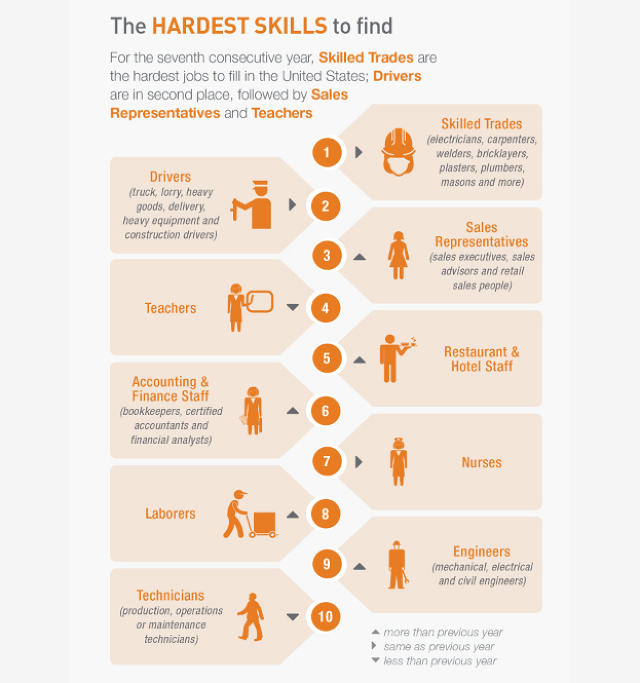U.S. Employers Have Too Much Available Labor, Not Enough Available Talent
As unemployment continues to hover around 5% this year, nearly half of all U.S. employers are struggling with talent shortages.
According to a recent survey of 42,300 employers around the world by The Manpower Group, a Milwaukee-based human resource consulting firm, 46% of American employers are having difficulty filling jobs, surpassing global averages. This is the highest percentage in the U.S. since 2012.
Unemployment levels for college graduates sits slightly higher at 5.6%, and jumps to 17.9% for high school graduates. Furthermore, underemployment in 2016 is a whopping 33.7%, compared with only 26.8% in 2007, according to a study by the Economic Policy Institute. And though 87% of college graduates feel prepared to enter the workforce, a recent study found that only half of hiring managers agree.

Though it may seem paradoxical, the struggles faced by both employers and employees simultaneously is a result of a wide variety of recent changes in the labor market, explains Sunny Ackerman, the vice president and general manager of Manpower U.S.
“Technology, shorter product cycles, shifting consumer demand, and new ways of working all mean that the jobs employers need done are evolving, and they need people with different skills to do them,” she says.
Another major cause of the talent shortage is an overall shift in the needs of businesses, and the desirable skills that result.
“We’ve found that even where there is a ready supply of labor, there isn’t always a ready supply of skills,” explains Ackerman. “In many ways the growing talent shortage reflects an issue of quality versus quantity. The challenge is finding people with the right skills and experience to do the work.”
As the workforce shifts toward more technical and skills-based jobs, businesses are becoming more efficient and eliminating older roles while creating new ones. As a result, employers are struggling to keep up with their changing skills needs.
To cope with these changes, on-the-job training has skyrocketed in the past 12 months. The Manpower study found that while only 12% of U.S. employers were training their employees a year ago, 48% reported up-skilling their staff in 2016.
“Employability—the ability to gain and maintain a desired job—no longer depends on what you already know, but on what you are likely to learn,” says Ackerman.

Companies like Coursera, which provides online courses from major universities, are responding to this demand, pivoting from an open learning platform toward job-specific training.
But mass on-the-job training could have some unintended consequences, suggests Ackerman. “Employers are tending to focus their up-skilling efforts on mid- to high-level roles, which still leaves a gap of skills development for people in entry-level positions,” she says.
Instead, Ackerman believes that organizations need to get more creative and flexible in their recruitment strategies. She recommends that they consider untapped talent pools, candidates who can be trained for the skills they may be lacking, and exploring different ways of filling roles, such as employing two part-time staff instead of filling one full time role. “It just takes a bit of creativity,” she says.
Fast Company , Read Full Story
(38)














